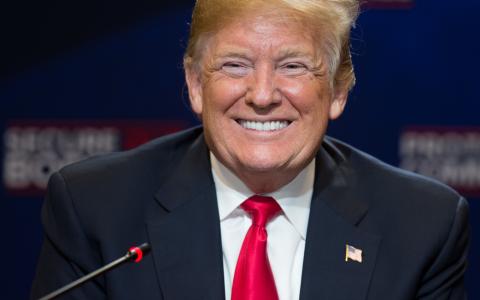
(Bloomberg) President Trump touched down in El Paso, Texas, today amid a national furor over racist gun massacres, a plummeting stock market, and growing signs that his trade war with China will fail to produce the historic deal he promised during his 2016 presidential campaign.
Each of these three developments hurts his standing with a key voter group he’s counting on to win a second term. The mass shootings in El Paso and Dayton, Ohio—and Trump’s reluctance to push strong gun control measures—is likely to exacerbate collapsing Republican support among suburban voters. In last fall’s midterm elections, Republicans were routed in suburban districts from Orange County to Dallas to New Jersey, where polls show college-educated professionals, especially women, strongly support measures to curb gun violence. “Republicans are headed for extinction in the suburbs if they don’t distance themselves from the NRA [and] put forth solutions to help eradicate the gun violence epidemic,” Dan Eberhart, a major Republican donor and Trump supporter told Bloomberg News.
That’s a bigger risk for Trump and Republicans than in the past. Gallup finds that gun control has gained salience as a voting issue over the past two decades, and nearly a quarter of voters say they’ll only support a candidate who shares their position. It’s no coincidence that the wave of Republican retirement announcements in the House these last two weeks has included districts close to Dallas and Houston and one stretching from suburban San Antonio to El Paso.
Trump owes much of his electoral victory to his strength in farm states. Many are already suffering from retaliatory tariffs imposed by China. On Monday, their plight worsened when the U.S. trade rival said it would suspend all imports of American agricultural products in response to Trump’s latest threat to place a 10% tariff on an additional $300 billion of Chinese goods. “China’s announcement that it will not buy any agricultural products from the United States is a body blow to thousands of farmers and ranchers who are already struggling to get by,” American Farm Bureau Federation President Zippy Duvall said in a statement.
Of all the groups in Trump’s coalition, falling support among farmers may be the least costly in electoral terms, since they hail from such deeply red areas. Last spring, a Bloomberg study of the 30 congressional districts most reliant on soybeans found that Republicans controlled 25 of them. Although Democrats made large gains in the midterm elections, those gains didn’t extend deep into farm country: Republicans still control 24 of those seats. Even so, a falloff of support in rural, agriculture-heavy regions of Iowa, Minnesota, and Wisconsin could prove meaningful by 2020.
Far more worrisome for Trump is the effect that this week’s events could have on the pivotal Upper Midwest. During the campaign, Trump blasted China for the decline of U.S. manufacturing jobs in states like Michigan, Wisconsin and Pennsylvania, promising to renegotiate trade terms and foster a Rust Belt renaissance. So far, those negotiations have backfired. China’s move on Monday to weaken its currency will reduce Chinese demand for U.S. goods and impose further economic stress on states Trump needs to help. “Disrupting supply chains in the short run will impact corporate profits, business confidence, and demand,” says Carl Riccadonna, chief U.S. economist for Bloomberg. “Thus, an already cooling manufacturing sector could in fact tilt into recession—which would be bad news for Rust Belt states.”
Indeed, one under-appreciated factor in the next election may be the sharp turnaround in U.S. manufacturing during Trump’s tenure. As this chart shows, output and jobs climbed steeply in 2017 and 2018:
But a sudden, precipitous drop beginning the previous fall is the opposite of what you’d want to see if you were running for reelection on the message that you’ve revitalized the Midwestern manufacturing economy.
Economists like Riccadonna, along with China hawks in the White House, will point out that in a trade war the deficit country (U.S.) has more leverage than the surplus country (China), which ends up bearing the brunt of the economic pain. But in a political context, that’s meaningful only in the long run. Trump’s timeline is much shorter: he needs to strike a deal before next November’s election to fulfill his campaign promise.
So far, there’s no sign that Trump’s repeated attempts to drive China to the bargaining table with punitive tariffs and bullying tweets are having the desired effect. He appears to be producing the opposite effect. Noting the heightened U.S.-China tensions, Goldman Sachs said in an August 5 note, “We no longer expect a trade deal before the 2020 election.”
Of course, Trump still has 15 months to go before Election Day and can count on the support of millions of diehards who won’t be swayed by racist massacres or sudden swoons in the Dow. But he’ll need to build a broader coalition to win a second term. Any week that he alienates farmers, suburbanites, and Upper Midwest voters makes it less likely that he can pull it off.



